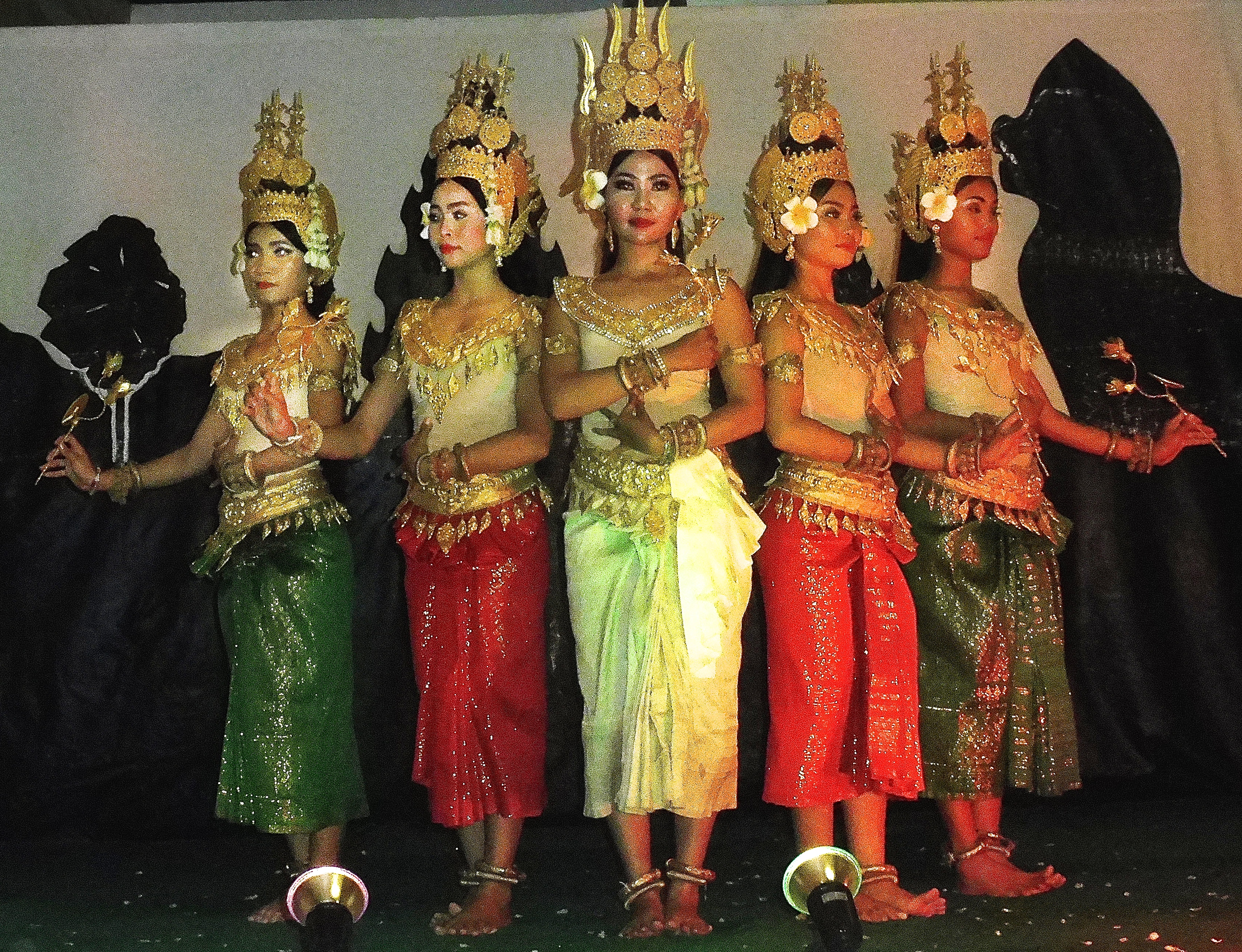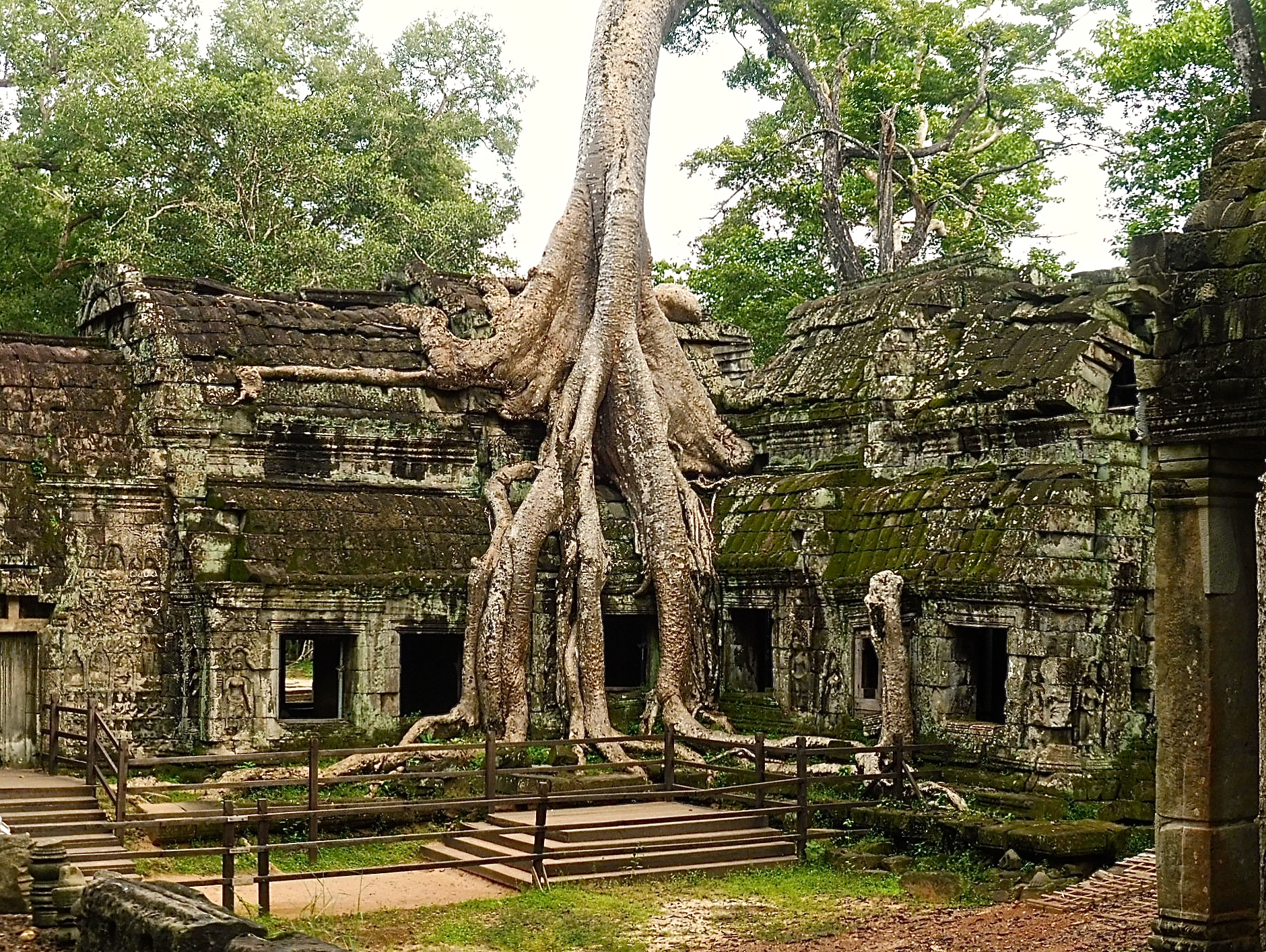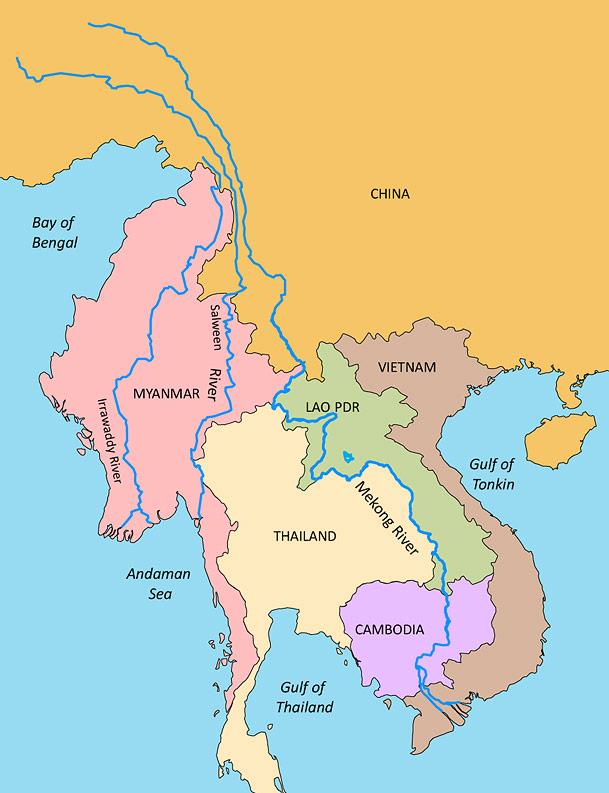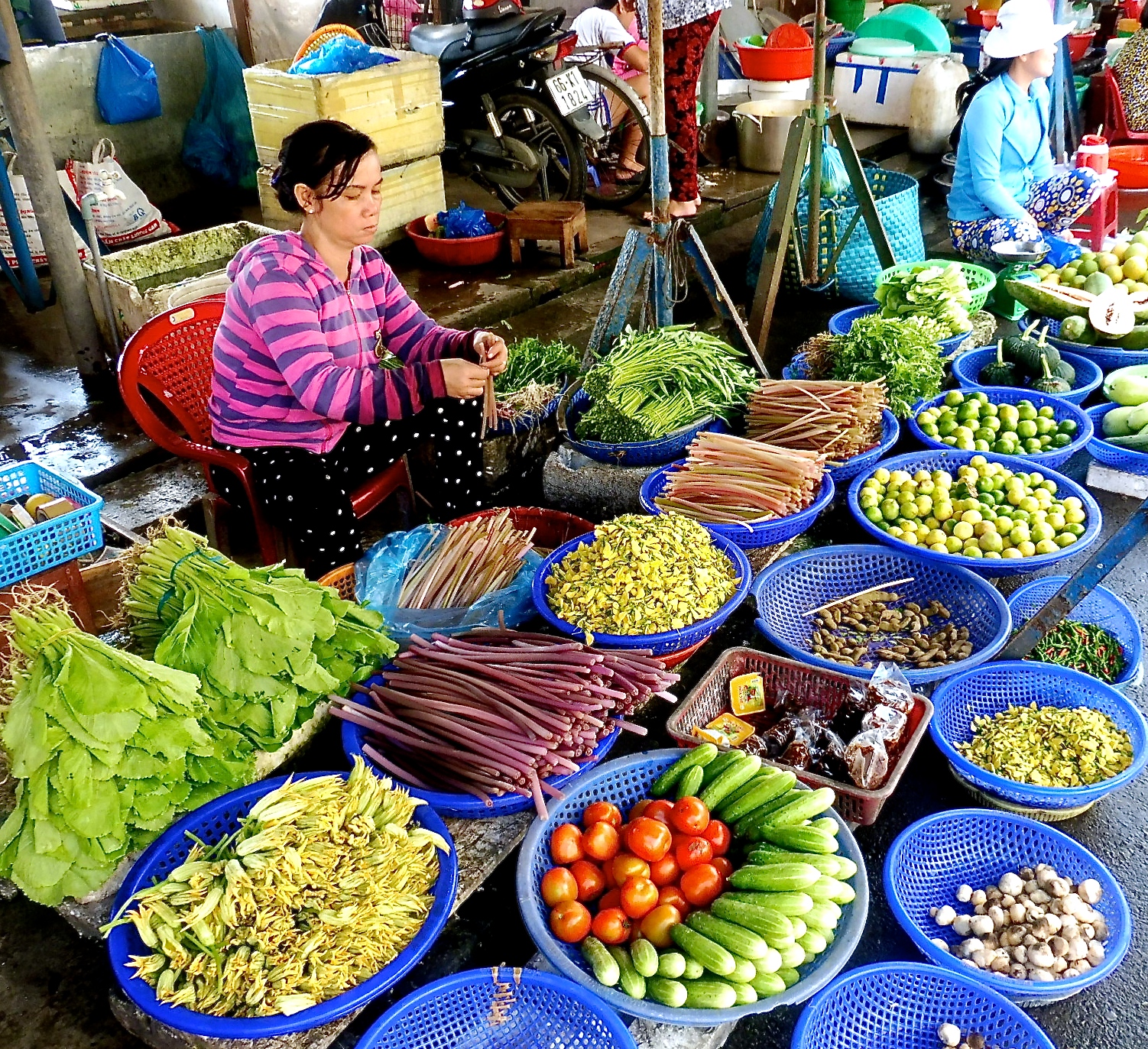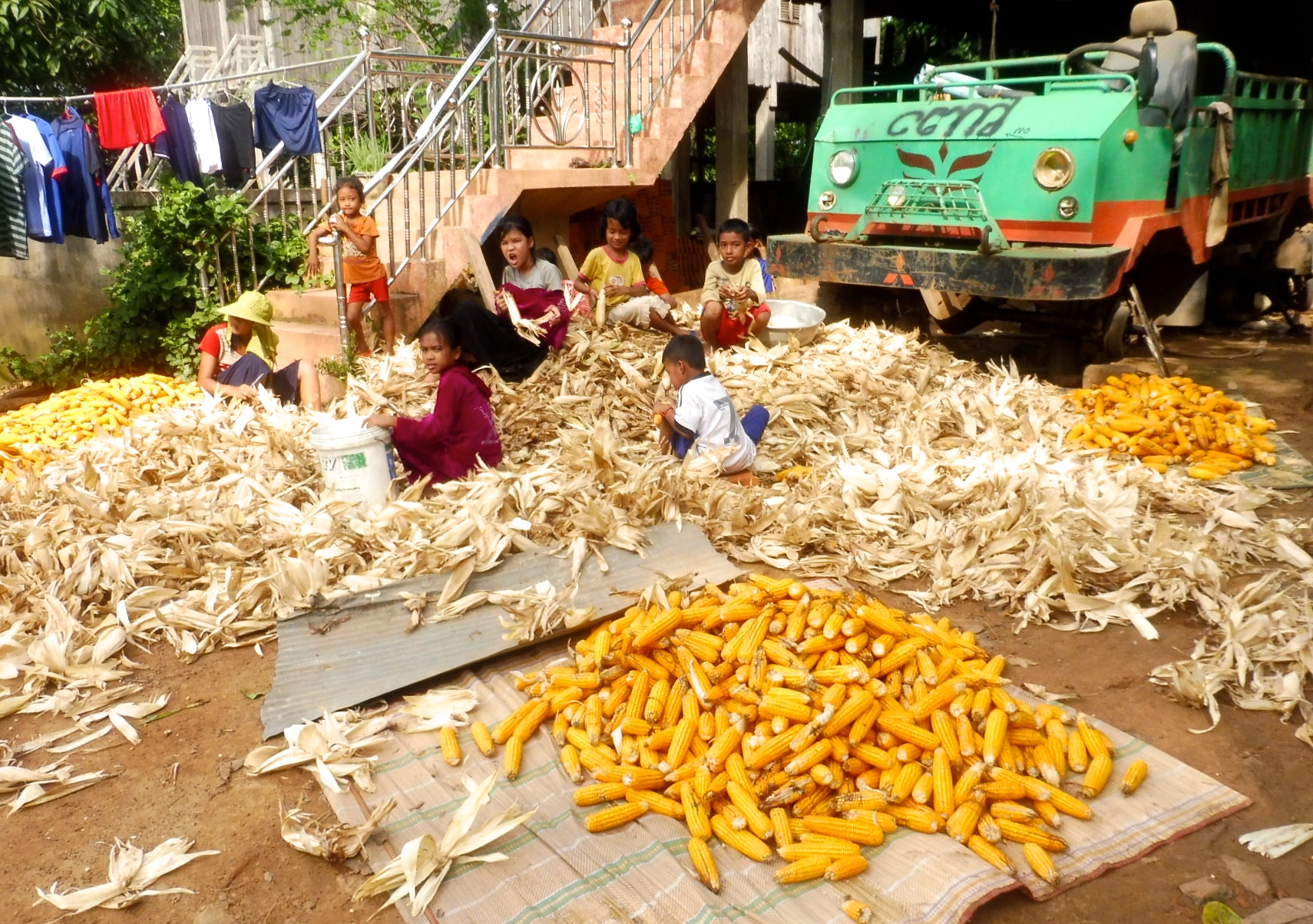Resilience of the Human Spirit
These young women were part of a group of Cambodian folk dancers who performed during our time in Siem Reap. The gentle movement of these dancers and their male counterparts was mesmerizing and clearly express the inner strength and peacefulness of the people.
Photos in these albums were selected from those taken mainly by Esther and Harold. In a few cases, representative photos selected from the Web.
November 11, 2016: Least We Forget
Remembrance Day in Canada (Link Here)
Veterans Day in the United States (Link Here)
Part I: The Rice Paddy
Part II: Indochina Wars: 1940 – 1990
Part III: Resilience of the Human Spirit
Part IV The Future Belongs to the Young
Part V Cruising the Mekong with Uniworld (being written) December 4. This part was split off to Part V. Part IV is being readjusted.
Part III: Resilience of the Human Spirit
1. The Sites and Sounds of Hanoi
Soon after arriving in Hanoi, we decided on a quiet walk through the downtown core late Sunday afternoon. It was a warm, humid evening, ideal for snapping a few after-dark photos of the treasures surrounding Hoàn Kiếm Lake and other nearby sites. On stepping from our taxi four blocks from the lake, crowds in the tens of thousands greeted us. We later guessed the number to be over 200,000.
The thousands of men, women, and children gathered undoubtedly set the tone for our emerging love of the people and their culture. While we could not speak their language, most young people were fluent in English, and they made us feel welcome and safe at every point. In our Western culture, we often perceive the world as filled with violent conflict. From an early age, we often become suspicious of strangers, particularly those different from ourselves.
On this night, in the heart of Hanoi, it seems people have found a way to come together for the common purpose of love, peace, and prosperity and not once in our travels did we see open conflict, a beggar (other than children that often congregated near some tourists sites) nor did we see a ‘down and out’ person huddled on the sidewalk or in a back alley. While alcohol is served in restaurants and other establishments, we never saw an intoxicated person.
The only police person we noticed was near the end of the event as he managed a congested traffic area. Perhaps they were in plain clothes but if they were, they never seemed needed as people peacefully celebrated block after 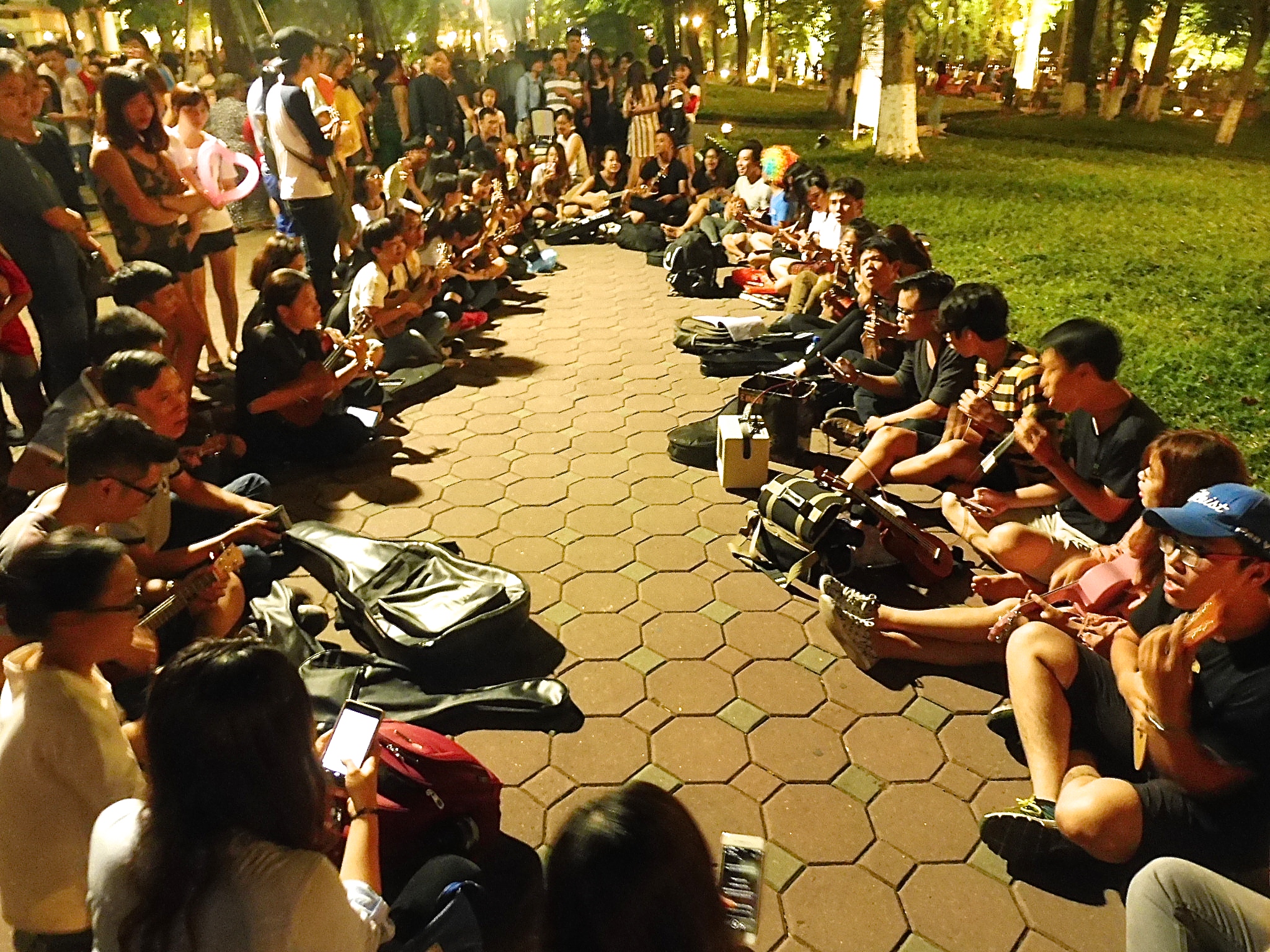 block in the city’s heart. Why were they celebrating? We determined it was a regular Sunday gathering for families and friends, sharing time playing games and music. Others, like ourselves, just strolled along and watched some event as we greeted and were greeted by others.
block in the city’s heart. Why were they celebrating? We determined it was a regular Sunday gathering for families and friends, sharing time playing games and music. Others, like ourselves, just strolled along and watched some event as we greeted and were greeted by others.
Young people (teens and adults, photo right) with mandolins, guitars, and various other instruments gathered in circles of twenty or thirty to play popular folk songs. Laughing and singing, they were eager to have us share in the fun as little children played games with their parents and other children. Older teens and adults competed in a twenty-person tug of war, alongside sandal races and other games, not so much to determine a winner but more in friendly competition.
Card games and board games with two to ten people took place on the sidewalk and park benches, as in this photo. Other young couples cuddled on park benches as food vendors pumped out their specialities. Other vendors offered inexpensive (but intricately made) items for tourists and visitors. In other areas, people gathered around professional musicians who played for free but accepted appreciation donations.
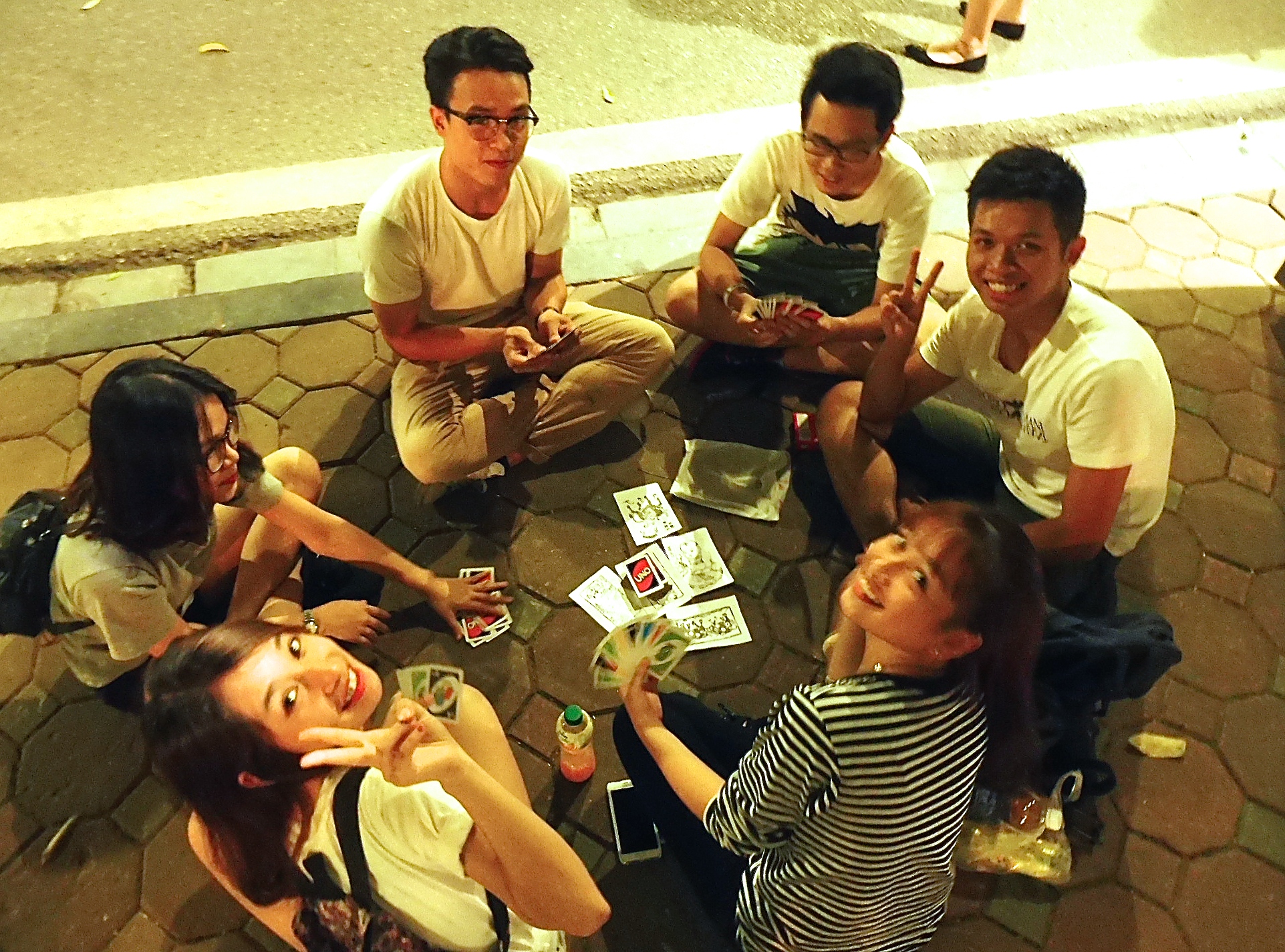 The only time I have ever witnessed this number of people involved in peaceful street interaction in Canada was during the 1996 Commonwealth Games in Victoria and again during the 2010 Olympics in Vancouver. However, even in those instances, there was a heavy police presence and homeless and street people, often given the bums rush if they dared show their face or began begging.
The only time I have ever witnessed this number of people involved in peaceful street interaction in Canada was during the 1996 Commonwealth Games in Victoria and again during the 2010 Olympics in Vancouver. However, even in those instances, there was a heavy police presence and homeless and street people, often given the bums rush if they dared show their face or began begging.
As we have only been travelling in Vietnam for a few days, I will need more time to reflect on why this general peacefulness permeates the country. The fact that this developing country has recently been through a horrendous war and suffered so many atrocities makes the question of peacefulness even more intriguing.
When we look back at how Canadians behaved during our past few elections and what is now happening in the US and other European countries facing elections, it makes me wonder if we can ever achieve the peace and tranquillity that seems so pervasive in Vietnam and Cambodia Come to think of it, perhaps the driver and pedestrian behaviour in extremely heavy traffic flow provides a clue. But first, a short description of our pre-tour excursion to Ha Long Bay.
Photo Album: A Memorable Visit to Hanoi
2. Ha Long Bay: A World Heritage Site
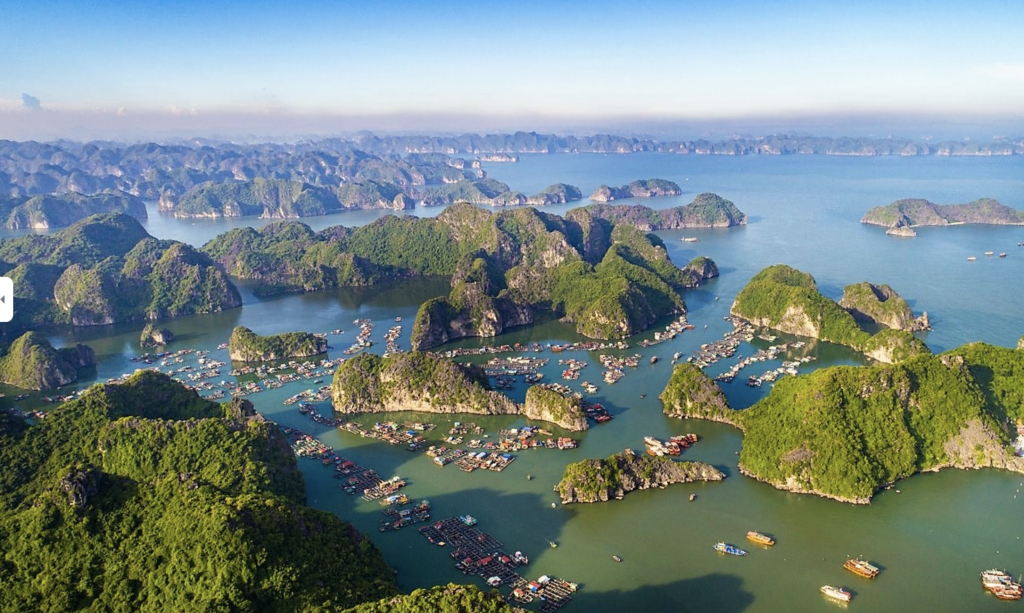
Photo (Web Source) Looking down from one of the limestone caves towards
our ship (top left).
As mentioned earlier, we had set aside two days for a visit to the World Heritage Site at Ha Long Bay, and it soon became evident why this area has become such a popular destination. Only three hours from Hanoi and a short drive from the border with China, a small city near Ha Long is being rebuilt as a tourist destination rather than an overnight stop. Even at this early stage of redevelopment, restrictions are being placed on the number of tour boats and ships allowed to operate within the area.
Following a three-hour drive east from Hanoi and after passing by Ha Phong Harbour, the world suddenly opens to an area of 1553 square kilometres containing nearly two thousand Islands and Islets formed from limestone karsts dating back some 500 million years. Many larger karsts have expansive caves, and the external walls of the karst would only be possible to climb with the proper gear.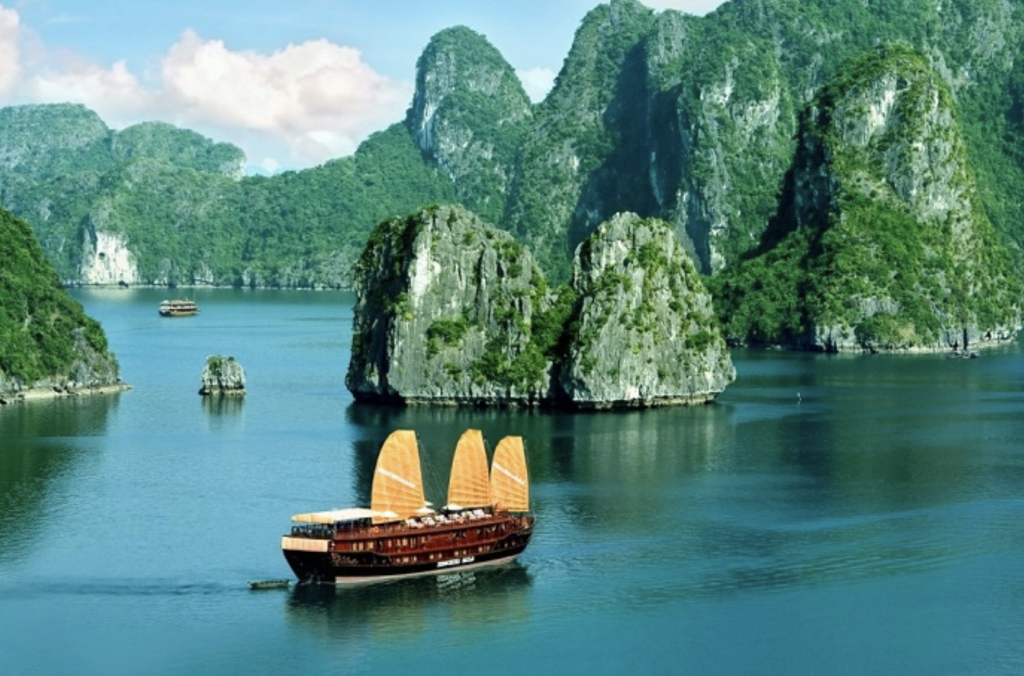
We toured one of the more extensive cave systems where Vietnamese soldiers holed up during WWII, from which they harassed the Japanese invaders and, at other times in history, the French and other American allies in wartime. In each instance, the invaders found it impossible to dislodge the Vietnamese defenders.
The Captain and ten crew of our small junk-type vessel, provided excellent service to our group of about twenty, including another couple from Victoria who lived only a few blocks from our home in Saanich. The young woman and her boyfriend were on a purchasing tour for her outlet store in UpTown Mall.
During our two days at sea, we visited various islands aboard our ship and in the small boats used to visit floating villages, inlets and caves.
Photo Album of Ha Long Bay
3. Standard of Living in Vietnam and Cambodia
First, let’s deal with the money. One of the reasons Garth and I became so popular, aside from our Blues Brothers routine and rugged good looks, was that we became overnight millionaires in Hanoi. As USD $100 equals VDN 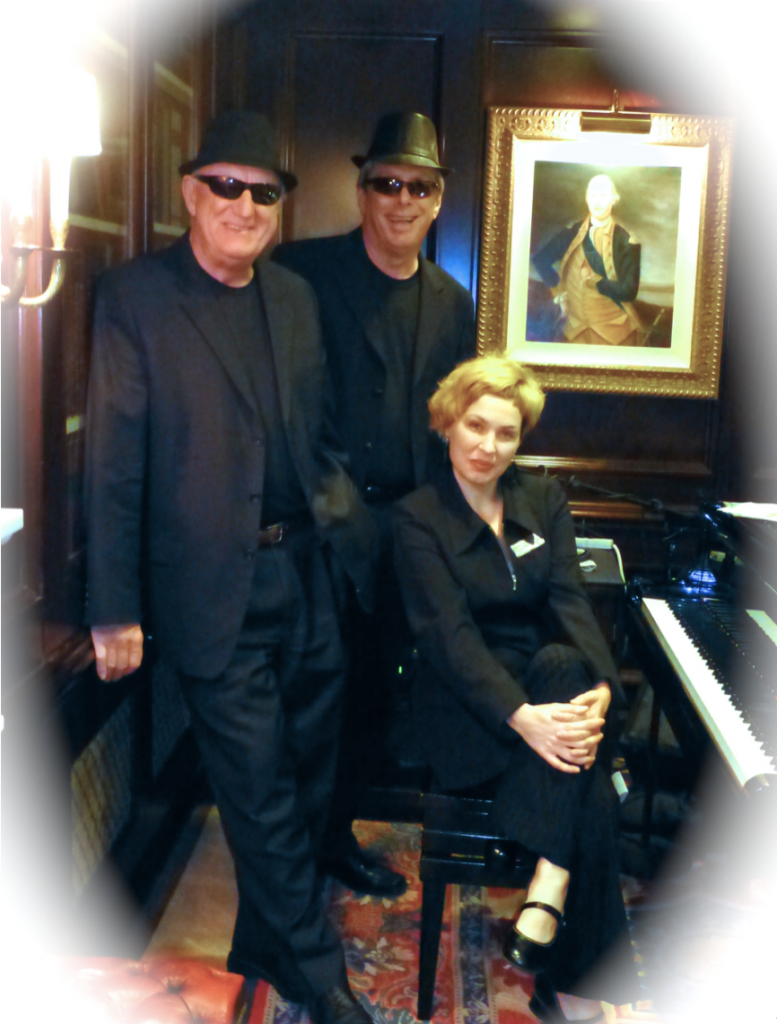 $25,000 (Vietnamese Dong), after we each exchanged USD $400, we became instant millionaires. Wow! It adds up fast, and with the price of goods and services being low by Canadian standards, that pile of money lasted reasonably well.
$25,000 (Vietnamese Dong), after we each exchanged USD $400, we became instant millionaires. Wow! It adds up fast, and with the price of goods and services being low by Canadian standards, that pile of money lasted reasonably well.
Photo: Garth and Harold with a Russian Jazz Pianist on our tour of the Middle East. As Lynn, Esther, Garth, and I quickly made friends with many entertainers and staff, we often travelled with them on excursions. They were always spoke openly about their country and life, so we received considerable information about other parts of the world than that in which we were travelling. One thing we learned is that cruise ship companies are not overly generous with their entertainers and line staff, therefore many cruise lines expect customers to make of the difference with all encompassing gratuities.
Beer sells for (all prices USD) $0.75 a bottle, and a 20-minute taxi ride to downtown Hanoi is $2.00. A five-course dinner for four, with two glasses of wine each, is about $35. A tip of $3.00 puts you in the big spender category, although service is always excellent whether you tipped or not. At one meal for four, Lynn was missing a couple of utensils for the next course and as an apology, the head server brought a fantastic dessert for four.
A reasonably well-employed worker in Hanoi makes $350 US dollars per month, and, with several family members working full time over ten years, a family can buy a small patch of land to build a home, a newer motorcycle or a car. Income tax starts once individual income exceeds $450 per month. Above that, the tax is progressive.
A high-end European vehicle costs about $70,000. However, a new 100 cc MC could be purchased for less than $200. That’s likely why there are 45 million motorcycles in Vietnam, a country of ninety million. As you travel through the country, you can often observe a new home built on top of another (a second or third story) – the reason is that land is scarce and relatively expensive, so when families expand (kids marry), they build upwards to the limit allowed. Beyond that, millions of Vietnamese residents live their entire lives on boats corralled in boat villages.
Later, when travelling to Cambodia (Kampuchea), the Cambodian Riel was lower at USD $100 = KHR $4,104. Just for the record, Garth and I were still popular. At some point, the government and banks of both countries decided it was confusing to keep changing money, so they adopted the US dollar as a regular currency. Go to a cash machine, and you get USD. Go to a restaurant, and the menus list USD. Of course, the locals still use VDN or KHR, but for tourists, why bother doing the calculation?
A Cambodian factory worker earns about $1.00 US per hour and works eight hours a day, six days a week (seven if 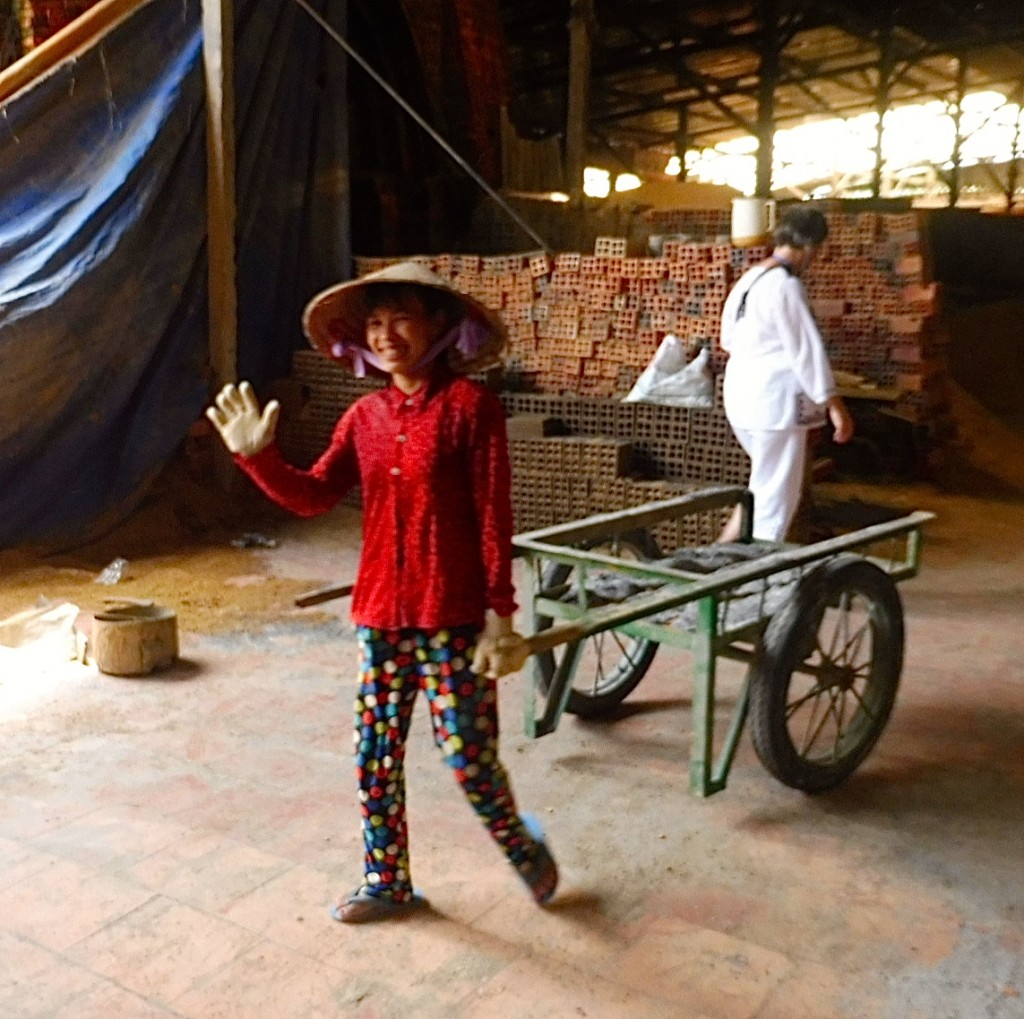 they wish). At about $200 a month, the income is on par with Vietnam when considering the differential exchange rate. That $1.00 per hour wage is about the same as I earned when working at manual construction jobs as a teenager in Alberta in the 1950s.
they wish). At about $200 a month, the income is on par with Vietnam when considering the differential exchange rate. That $1.00 per hour wage is about the same as I earned when working at manual construction jobs as a teenager in Alberta in the 1950s.
Photo: A young woman in Cambodia working in a brick factory where she hauled raw bricks to the firing furnace. A hard job by our standards be seemingly very happy as she greeted us and spoke about her work (in perfect English)
Working conditions seem about the same in the clay building blocks factory we visited, and child labour (under 16, I think) is against the law, so one could surmise the standard of living for ordinary workers in Alberta in the 1950s was not much lower than in Cambodia and Viet Nam today. Not bad for a developing country just recovering from a hundred years of war and one of the worst genocides in the last half of the 20th century.
I don’t recall thinking I was hard done by back in the 1950s, and I don’t sense the people of Vietnam or Cambodia feel that way today. They are doing as I did, making their way through life. I could buy a relatively good car (mom loaned me the money), take my girlfriend to the drive-in, and even buy her popcorn if I was feeling flush. I also spent ungodly time and money drinking with the boys. (link here to Cold Lake High School Years).
In Cambodia and Vietnam, I think the young population is likely among those countries where I sense, they are happy. Such was not the case in countries we visited. It’s fairly easy to get a sense about the level of happiness of young by watching them at gatherings and in the work place, and when the moment is right, engaging them in conversation. It’s surprising how many individuals will be candid in their conversation when speaking with a stranger from another country.
4. And a few words about traffic.
It will take a first-time visitor a few days to become comfortable with the traffic flow, as you may think death could come within the first few blocks. But, stop, take a few minutes to observe the locals and try to feel the rhythm of
the city, and when crossing streets, keep moving and don’t stop to second-guess. While drivers and pedestrians are 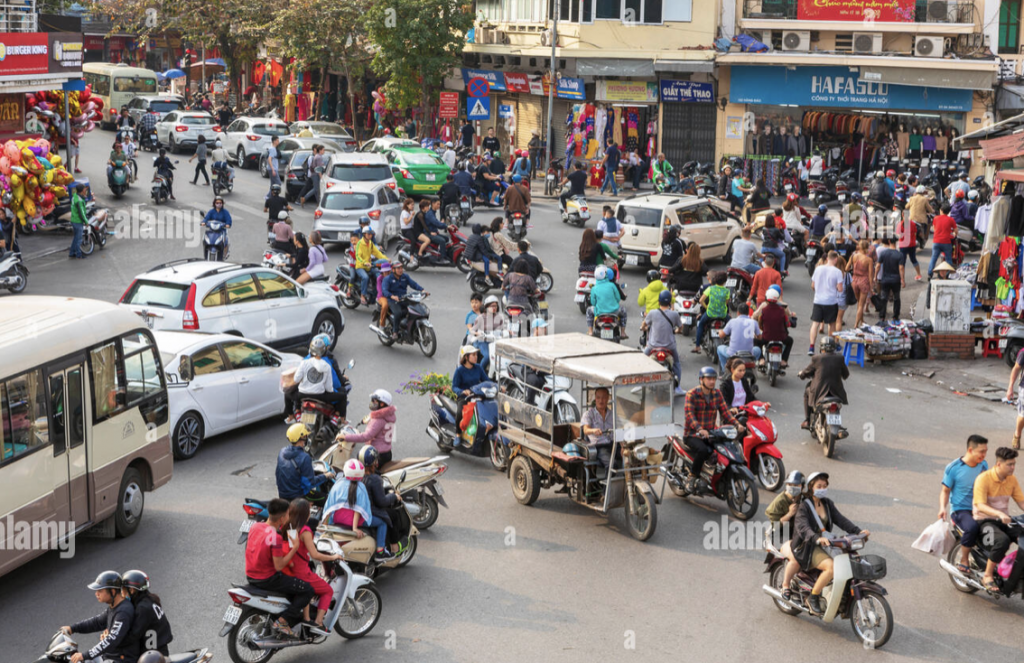 polite, they expect (or want) you to dawdle.
polite, they expect (or want) you to dawdle.
Photo (web) You should practice walking or driving through light two-way traffic before you try the big time as shown in this photo.
Tens of thousands of vehicles (mostly motorcycles) and pedestrians thread their way through the city in free flow. It is an excellent example of Heisenberg’s Uncertainty Principle (there are limits to which complementary particles can be measured for position and momentum ). That sums up the traffic flow. It’s an entirely different story in China, where you travel with one hand on the horn and the other in the hospital.
Across the Middle East, there are few traffic rules and virtually no visible enforcement. The ebb and flow is so smooth it is not unlike a giant pulsating amoeba flowing through the city’s heart. Every available space on sidewalks and roadways is used, and while horn honking is prevalent, there is no sense of urgency or done with malicious intent. A gentle honk alerts others you intend to fill an empty (or partially open) space. Moms, dads, and kids crowd on motorcycles and bicycles, cell phones in hand and regular use by passengers and drivers alike. Signal lights are not required, and rear-view mirrors would be useless as the outlandish loads often obstruct the driver’s view entirely other than directly in front.
In Western society, traffic flow represents the opposite in that individual drivers aggressively (more often men than women) assert their right to move ahead of the vehicles leading the way. If you can’t move faster than the guy
behind you, get out of the way until you learn how to drive. Put two men side by side at a stop light, and you will  see a casual sideways glance as each assesses their chance of being first off the line. It’s a game of chicken involving thousands of high-powered cars fitted with the latest safety devices and, for males, whose testosterone peaks when they slip behind the wheel, a form of sexual dominance. Seeking to temper this behaviour, governments have created thousands of mind-numbing traffic laws, a list that grows daily. Then millions of dollars are spent enforcing those laws.
see a casual sideways glance as each assesses their chance of being first off the line. It’s a game of chicken involving thousands of high-powered cars fitted with the latest safety devices and, for males, whose testosterone peaks when they slip behind the wheel, a form of sexual dominance. Seeking to temper this behaviour, governments have created thousands of mind-numbing traffic laws, a list that grows daily. Then millions of dollars are spent enforcing those laws.
Photo (Web Source) While it is understandable a police officers needs to use the police car as a shield, that officer needs to also exercise discretion as to where the stop is made.
Many times traffic units on the Pat Bay Highway (#17) between Victoria and the Swartz Bay Ferry Terminal, will block one lane of two lanes of heavy traffic to write the ticket. That action creates all kinds dangerous situations as drivers are forced to quickly slow and merge into the centre lane.
The result of all these laws is periodic traffic gridlock in most North American cities. These traffic-flow challenges can’t be fixed because the need to compete is embedded in our psyche. If you want to observe aggressive drivers on steroids, travel to any city or town in a resource-rich province or state where every man, woman and child owns a giant V8 pick-up truck. The road becomes a battleground of the toughest and fastest. Welcome to North America.
5. Siem Rep, Cambodia: A Spiritual Wonderland
It is not possible in a few paragraphs to capture the ebb and flow of religious belief and life in the region, but while Viet Nam and Cambodia bear some resemblance, Cambodia seems to have a stronger history of attachment to Buddhism and Hinduism mixed with a tinge of Confucianism and Christianity.
The country is filled with symbols and structures related to those belief systems with the most famous being the Angkor temples that surround Siem Reap. Monasteries dot the countryside and our guide (a man with long experience in Cambodia) was at one time a practicing Monk.
The most famous of Angkor Temples, Ta Prohm, (photo below, hdmc) featured prominently in the movie Lara Croft: Tomb Raider. (photo below) Ta Prohm is the only site that was left more or less as it was when re-discovered buried in the jungle in early in the 20th century.
I have no deep understanding of the Eastern philosophies, but in my superficial western way, it seems the general spiritualism which permeates the region has played a significant role in helping people come to terms with the horrendous events visited their lives over the past fifty years (war and genocide). Because spirituality tends to look inward towards ones self, family, ancestors and spirits, it tends to promote a peaceful, respectful calmness that penetrates to the core of individuals and families, with families and ancestors being held near the centre. The fact the region has ebbed and flowed between several similar belief systems (Buddhism, Confucianism, Hinduism, Animism, etc.) over the past several hundred years, suggests there is not a built up of animosity between them.
Very little of this seems to hold true within the theist systems (Muslims, Jews and Christians) as they have been locked in a battle for the hearts and minds of the people for over 2000 years. Even groups within the same stream are broken into thousands of subsets each of which claims only they know the path to salvation. Each day news outlets, those standing for government office, government agencies and individuals proclaim their fear and hatred of other religions. Check the posts on your own FB page or go to any of a hundred different mainstream blogs and almost every political party, once in election mode, each begins to stoke those flames of fear.
While I am fully aware there are constraints that come with living in a Communist system in which freedom of speech and assembly is limited, that certainly wasn’t visible in any of the English language newspapers in Viet Nam and Cambodia. I rather suppose one of the greatest restrictions in a Communist state, is the inability to elect to office persons the people may think best represent our interests, and in a one-party system, it seems likely financial power accumulates in the hands of party favourites. It is hard not to expect the same thing is taking place in Western countries, it’s just dressed up in different clothes.
As for Viet Nam, as opposed to Cambodia, the attachment to religion does not seem as strong, yet it still holds a presence that seems to capture the imagination as to how people are expected to conduct their lives (introspective rather than to an external God) We did visit one interesting temple (if that is what it is called) that combines Buddhism, Taoism, Confucianism and Catholicism, in a system called Caodaism. The system was officially recognized in 1985 and now has about six million follows worldwide. Again, the system seems to point more toward an internal reference point rather than the external God.
Photo Album: A Visit to Siem Reap
6. A River of Life – The Mekong
At 4300 km., the Mekong is the 11th longest river in the world stretching from the Tibetan plateau through China, Myanmar, Laos, Thailand, Cambodian and finally spreading out in the Mekong Delta area of South Viet Nam. In the floodplain area of Lake Tonie Sap in Cambodia, seasonal various in water levels cause a reverse flow in the Mekong. Even as we were flying in from the Northeast of the lake towards Siem Reap, it seemed as if the last hour and a half was over floodplain that looked as large as an ocean from our vantage point at 31,000 feet.
Where the Mekong flows into the Delta, a backflow of saltwater from the South China Sea can reach 50 km. inland and in one instance two years ago the inflow stretched 100 km. That salt flood killed thousands of acres of rice and other field crops.
While the annual flush from heavy rains upstream tended to clear smaller, annual, saltwater intrusions, during the flood season, the continued building of dams in the upper reaches of the Mekong, is slowly lowering the seasonal differences in water level and that is forcing many riverbank farmers off their traditional land. The reason, a lack of flooding is blocking over 80% of silt that provides nutrients, the lifeblood of the lower Mekong.
With a basin population estimated at 60 million, farming and fishing along the Mekong provide the sustenance to the peoples of several nations along the waterway and any disruption of the flow will be catastrophic. In our travels, we were extremely fortunate to be able to travel along several tributaries in Sampans in order to visit small villages and fish farms that supply food to the nation.
7. Farm to Table
‘Farm to Table” is given new meaning in Viet Nam and Cambodia. Whether in small villages or a city of millions, the food being cooked for breakfast lunch and dinner is seldom older than two days new stocks arrive fresh each day.
In the cities, thousands of motorcycles piled high with farm-fresh fruits, vegetables, meat, poultry fish, eggs and hundreds of products begin arriving fresh by 3:00 am each morning and by at 6:00 am the stalls are opening. They close when sold out or by close 8:00 pm. While some venders deal through middlemen, most buy and sell direct as independent operators.
While most major cities also have ‘hypermarkets’ the foods for sale in those locations are similar in style to the street vendors only consolidated and likely an even greater variety. We did not attend one of the hypermarkets, but sites I looked at suggesting they can be very crowded.
Because the entire region has a moderate that permits up to four rotational crops per year, fresh fruits and vegetables are available year-round within 50 km of the city centres. Street vendors generally maintain only the amount of stock that will sell out each day, but if for some reason they have a bit leftover, it will be sold at a lesser price the next day. While fixed prices are not set among venders, each usually sells similar type items within the same range yet customers are free to try and negotiate a better deal. Good food that is leftover from the second day is often donated directly to charities, orphanages, monasteries, and others in need.
Fish and poultry are often brought to city dwellers but can be killed and cleaned as requested by the purchaser. There seems no end of items as might be available in the fresh food section of the supermarket in Canada including, but additional items such as rats (rice feed only), beetles and snakes are popular items sold in street markets. If your preference is to have someone else cook your food, there are virtually hundreds of small restaurants and thousands of food carts dotting the streets.
As for dry goods and other services, there are thousands of mom and pop outlets providing a thousand different services and goods. I suppose there are large outlet stores for these items, but, again, we did not go looking for that type of outlet as everything we might want could be found on the street.
8. Small Villages and Homes.
Small Village Life (hdmc): The children in this household along with a few friends shucking corn. Nothing will be wasted as every piece of the corn stalk will be used for some purpose. Every child you see has a smile on their faces and obvious love in their hearts.
While many westerners may consider the conditions in the small farming and fishing villages to be primitive by our standards, there is clearly a family and community cohesiveness that far exceeds that which is found back in cities and towns across Canada. Visitors are welcomed with open arms and children, as with children everywhere, are fun to be around. In those places, we visited they always approached and engaged with a smile. Those who spoke English were eager to use their English words.
Some may even touch your tummy as a sign of respect particularly if it has a Buddha-like quality. They then ask “what is your name” and “how old are you”. In return, those same questions are asked of them and they respond in clear English. In each village kids were playing as adults went about the daily activities of life which may have been cleaning the house, splitting and hauling wood or cleaning the animal pens. Many of the villagers likely worked at one of the more distant factories or as fishermen. While there was likely some role-specific tasks, it seemed that most roles were filled with men and woman more or less equally.
The homes that usually sit atop a number of pillars under which stock (chickens and cattle) were free to move. The kids were task with cleaning up any manure in the morning. The pigs seemed to be kept in separate pens. While the villages and small farmyards were often cluttered, everything was tidy in its own way. I could not help but think back to my early life on farms in Alberta and Saskatchewan.
9. The Family Unit
Information from our guides, particularly on our trip to Ha Long Bay (a six-hour return trip) various other sources and observations made during our travels, suggests family units in Viet Nam 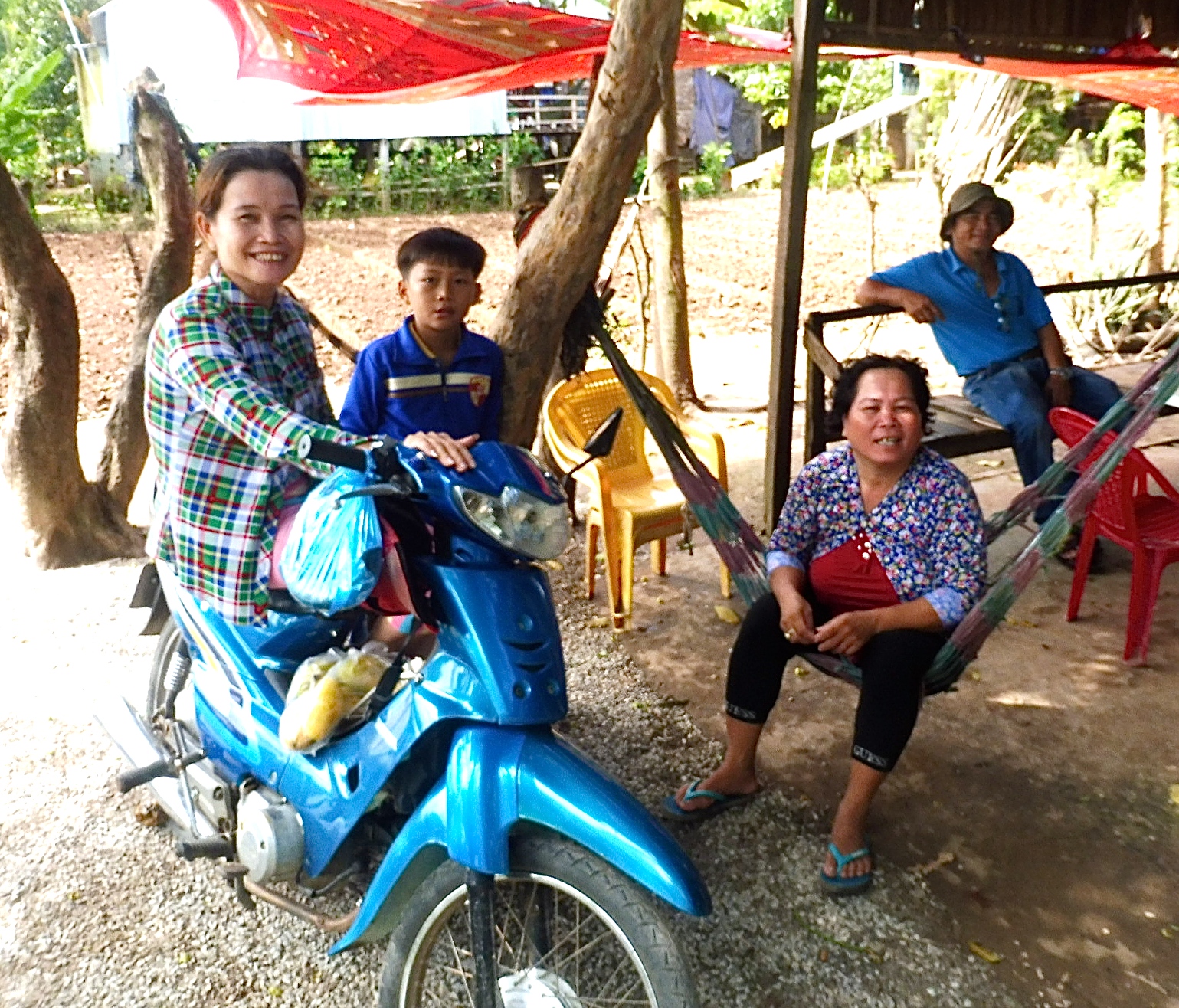 are extremely strong with two or three generations living in the same home. It is said it takes a community to raise a child, and from we have learned so far the children of both Viet Nam and Cambodia are truly being given a head start. Even though our standard of living, educational opportunity, and health care is much higher in Canada, I have a sneaking suspicion our extended family cohesiveness is being extinguished in direct proportion to our overall increase in wealth.
are extremely strong with two or three generations living in the same home. It is said it takes a community to raise a child, and from we have learned so far the children of both Viet Nam and Cambodia are truly being given a head start. Even though our standard of living, educational opportunity, and health care is much higher in Canada, I have a sneaking suspicion our extended family cohesiveness is being extinguished in direct proportion to our overall increase in wealth.
Over the past several years of travel, it never ceases to amaze me how quickly we can have our eyes opened to some of the shortcomings of our own country when we begin to walk among the “disadvantaged” of another. I will again go back to traffic flow as an example of the high degree of peace and goodwill that manifests itself in Viet Nam and Cambodia.
Hanoi has a population of some 7.5 million with about 4.1 million motorcycles. In all of Viet Nam there are 90 million people with 45 million motorcycles so it does not take long to realize the drivers of those 45 million motorcycles have a high degree of respect for others using the roadway and a full confidence that other drivers will meld into the give and take needed to keep everyone moving towards their destination.
It seems certain that sense of dignity and respect did not begin the first time a child mounted their bicycle or a teen his or her motorcycle, it had to begin in the home and at school. I am not suggesting that in America we are without caring gentle people, but in everyday life there is so much pressure to succeed (by western standards) that much of the natural cohesiveness and caring that we share between and among our children is slowly bled away as we move through High School, College and then into the workplace. We are trained to become competitive adults where first past the post is the winner. For those lost along the way, well that’s just too bad, they should have worked harder to get ahead.
To discuss the impact the young are having in Cambodia and Viet Nam, as well as many other nations around the world, link to Part IV, below.
Part I: The Rice Paddy
Part II: Indochina Wars: 1940 – 1990
Part III: Resilience of the Human Spirit
Part IV The Future Belongs to the Young
Photo Albums
The mighty Mekong: Lifeblood of Indochina: Life Along the Mekong
Our travel companions and those we met along the way: Friends
Hanoi and Saigon – 12 million friendly, busy people: Cities and People
The glue that binds the past, present, and future: Spiritualism in Indochina
The arts have never died in Indochina: Music, Dance, and Art
Get Fresh, is a way of life in Viet Nam and Cambodia: From Farm to Market
Two developing nations: a place where everyone wants to learn and work: Schools and Factories
Pedestrians and people have learned how to share the road: In one word – Respect
Two nations of small farms provide food for 105,000,000 and the world: Farms and Villages
(838)
Trackback from your site.

